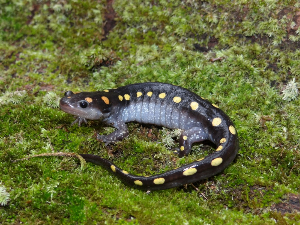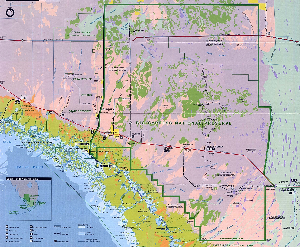Search ARMI Database
Search term(s)
Contribution Number
Search Results
879 record(s) found.
Papers & Reports Body size affects the predatory interactions between introduced American Bullfrogs (Rana catesbeiana) and native anurans in China: an experimental study
Authors: Y Wang; Z Guo; Christopher A Pearl; Y Li
Date: 2007 | Outlet: Journal of Herpetology 41: 514–520
Papers & Reports The effect of community composition on persistence of prey with their predators in an assemblage of pond-breeding amphibians
Authors: Susan C Walls; M G Williams
Date: 2001 | Outlet: Oecologia 128: 134-141
We examined whether the species composition of a community influences the persistence of larval Ambystoma maculatum in assemblages composed of two larger intraguild predators (A. opacum and A. jeffersonianum) and an alternative prey species (tadpoles of Rana sylvatica). We predicted a priori that A. maculatum would have higher survival in more diverse communities containing alternative species of prey and top predators (A. opacum), the latter of which may lower the abun-dance of intermediate predators (A. jeffersonianum) via intraguild predation. In a factorial experiment, we manipulated the presence of larval A. opacum, A. jeffersonianum, and R. sylvatica in replicated artificial ponds containing larval A. maculatum. The presence of all three species significantly depressed biomass production in A. maculatum: biomass was highest in ponds lacking the other species and was zero in ponds initially containing all four species. Tadpoles severely reduced the growth of filamentous algae in the ponds. This, in turn, may have affected the abundance of some herbivorous prey of larval salamanders, although this possibility was not tested. The presence of congeneric predators severely restricted the presence in the water column of larval A. maculatum, which otherwise exhibited significant diel patterns of activity in the absence of predators. Together, the presence of tadpoles and a predator-mediated reduction in activity patterns may have limited foraging opportunities for A. maculatum, thus exacerbating the direct impact of predation on survival in this species. These results suggest that diverse assemblages consisting of these particular species may actually inhibit, rather than promote, inclusion of A. maculatum in some communities of pond-breeding amphibians.
Papers & Reports Interspecific differeneces in susceptibility to competition and predation in a species-pair of larval amphibians
Authors: Susan C Walls; D G Taylor; C M Wilson
Date: 2002 | Outlet: Herpetologica 58: 104-118
Fundamental issues in the study of predator-prey interactions include addressing how prey coexist with their predators and, moreover, whether predators promote coexistence among competing prey. We conducted a series of laboratory experiments with a freshwater assemblage consisting of two predators that differed in their foraging modes (a crayfish, Procambarus sp., and the western mosquitofish, Gambusia affinis) and their prospective anuran prey (tadpoles of the narrow-mouthed toad, Gastrophryne carolinensis, and the squirrel treefrog, Hyla squirella). We examined whether competition occurs within and between these two prey species and, if so, whether the non-lethal presence of predators alters the outcome of competitive interactions. We also asked whether the two species of prey differ in their susceptibility to the two types of predators and whether interspecific differences in predator avoidance behavior might account for this variation. Our results indicated that Gastrophryne was a stronger competitor than Hyla; at high densities, Gastrophryne reduced the body size of both congeners and conspecifics, as well as the proportion of surviving conspecifics that metamorphosed. However, the presence of mosquitofish did not alter the outcome of this competition, nor did either type of predator affect the density-dependent responses of Gastrophryne. In laboratory foraging trials, the number of tadpoles of each prey species that was killed, but not completely consumed by mosquitofish, was similar for Gastrophryne and Hyla. Yet, significantly more individuals of Gastrophryne than of Hylawere the first prey eaten by mosquitofish; there was no difference in the number of individuals of each species eaten by crayfish. Overall, more individuals of Gastrophryne than of Hyla were killed and completely eaten by mosquitofish at the end of the experiment. The two species of prey did not differ in their spatial avoidance of either type of predator, suggesting that this behavior did not play a significant role in the differential vulnerability of the prey to predation. By reducing the abundance of G. carolinensis, the potential exists for predators, such as mosquitofish, to ameliorate this species' competitive impact on other species. In this way, predators may promote coexistence of species within some assemblages of amphibians.
Papers & Reports Leaf litterbags – Factors affecting capture of stream-dwelling salamanders
Authors: J L Waldron; Kenneth C Dodd; J D Corser
Date: 2003 | Outlet: Applied Herpetology 1: 23-26
Many standardized techniques are used to monitor terrestrial salamanders, but fewer protocols have been tested for inventorying stream-dwelling salamanders, especially larvae. One new method uses artificial refugia (leaf litterbags) placed in shallow streams. To test the utility of litterbags, we sampled three transects of 6 litterbags each (2 large, 2 medium, and 2 small) placed in five small, medium, and large streams in Great Smoky Mountains National Park, an area of high aquatic salamander diversity. We captured 690 larval, juvenile, and adult stream-dwelling salamanders of 11 different species from June to November 2000 in the 90 litterbags. Large and medium-sized litterbags were most effective at sampling salamanders in small streams, but all bag sizes worked equally well in medium and large streams. The number of salamanders captured varied seasonally, with most captures in June and July. The depth of bag submergence significantly influenced litterbag use by adult and larval salamanders, but had no effect on juvenile salamanders. Although the technique was effective for determining the presence of many salamander larvae, variation in the numbers of individuals captured and the inability to relate captures to overall abundance make it impossible to monitor trends without considerable additional effort. The ease of deployment and non-destructive methodology suggest that litterbags could be useful in determining salamander presence during inventory programs, especially when the time to sample a large number of sites is limited.
Papers & Reports Use of amphibians as ecosystem indicator species
Authors: Hardin J Waddle
Date: 2006 | Outlet: Gainesville: University of Florida
Ph.D. dissertation on amphibians as indicator species for Everglades restoration success and park management.
Papers & Reports Efficacy of automatic vocalization recognition software for anuran monitoring
Authors: Hardin J Waddle; T F Thigpen; Brad M Glorioso
Date: 2009-04-24 | Outlet: Herpetological Conservation and Biology 4: 384-388
Surveys of vocalizations are a widely used method for monitoring anurans, but it can be difficult to coordinate standardized data collection across a large geographic area. Digital automated recording systems (ARS) offer a low-cost method for obtaining samples of anuran vocalizations, but the number of recordings can easily overwhelm human listeners. We tested Song Scope, an automatic vocalization recognition software program for personal computers to determine if this type of machine learning approach is currently a viable solution for anuran monitoring. For three species, Song Scope scanned more than 200 h of recordings in 3-20 h at the settings we chose. The software misidentified true calls (false positive) at rates of 2.7%-15.8% per species and failed to detect calls (false negative) in 45%-51% of recordings. There exists a tradeoff between false positive and false negative errors, which can be adjusted by setting the minimum criteria for the recognition software. Users of this approach should carefully consider their reasons for monitoring and how they intend to use the data before creating a large monitoring network.
Papers & Reports Using personal digital assistants to collect wildlife field data
Authors: Hardin J Waddle; Kenneth G Rice; H F Percival
Date: 2003 | Outlet: Wildlife Society Bulletin 31: 306-308
Describes a method for automating wildlife data collection and entry by using PDAs in the field
Papers & Reports Modeling the effect of toe clipping on treefrog survival: beyond the return rate
Authors: Hardin J Waddle; Kenneth G Rice; Frank J Mazzotti; H F Percival
Date: 2008 | Outlet: Journal of Herpetology 42: 467-473
Some studies have described a negative effect of toe clipping on return rates of marked anurans, but the return rate is limited in that it does not account for heterogeneity of capture probabilities. We used open population mark-recapture models to estimate both apparent survival (0) and the recapture probability (p) of two treefrog species individually marked by clipping 2-4 toes. We used information-theoretic model selection to examine the effect of toe clipping on survival while accounting for variation in capture probability. The model selection results indicate strong support for an effect of toe clipping on survival of Green Treefrogs (Hyla cinerea) and only limited support for an effect of toe clipping on capture probability. We estimate there was a mean absolute decrease in survival of 5.02% and 11.16% for Green Treefrogs with three and four toes removed, respectively, compared to individuals with just two toes removed. Results for Squirrel Treefrogs (Hyla squirella) indicate little support for an effect of toe clipping on survival but may indicate some support for a negative effect on capture probability. We believe that the return rate alone should not be used to examine survival of marked animals because constant capture probability must be assumed, and our examples demonstrate how capture probability may vary over time and among groups. Mark-recapture models provide a method for estimating the effect of toe clipping on anuran survival in situations where unique marks are applied.
Papers & Reports A new parameterization for estimating co-occurrence of interacting species
Authors: Hardin J Waddle; Robert M Dorazio; Susan C Walls; Kenneth G Rice; Jeffrey Beauchamp; M J Schuman; Frank J Mazzotti
Date: 2010 | Outlet: Ecological Applications 20: 1467-1475
Models currently used to estimate patterns of species co-occurrence while accounting for errors in detection of species can be difficult to fit when the effects of covariates on species occurrence probabilities are included. The source of the estimation problems is the particular parameterization used to specify species co-occurrence probability. We develop a new parameterization for estimating patterns of co-occurrence of interacting species that allows the effects of covariates to be specified quite naturally without estimation problems. In our model, the occurrence of one species is assumed to depend on the occurrence of another, but the occurrence of the second species is not assumed to depend on the presence of the first species. This pattern of co-occurrence, wherein one species is dominant and the other is subordinate, can be produced by several types of ecological interactions (predator–prey, parasitism, and so on). A simulation study demonstrated that estimates of species occurrence probabilities were unbiased in samples of 50–100 locations and three surveys per location, provided species are easily detected (probability of detection 0.5). Higher sample sizes (.200 locations) are needed to achieve unbiasedness when species are more difficult to detect. An analysis of data from treefrog surveys in southern Florida indicated that the occurrence of Cuban treefrogs, an invasive predator species, was highest near the point of its introduction and declined with distance from that location. Sites occupied by Cuban treefrogs were 9.0 times less likely to contain green treefrogs and 15.7 times less likely to contain squirrel treefrogs compared to sites without Cuban treefrogs. The detection probabilities of native treefrog species did not depend on the presence of Cuban treefrogs, suggesting that the native treefrog species are naive to the introduced species.
Papers & Reports Eleutherodactylus coqui: Geographic distribution
Authors: Hardin J Waddle; M E Crockett; Kenneth G Rice
Date: 2006 | Outlet: Herpetological Review 37: 487
Documents the discovery of the Puerto Rican Coqui on St. John, USVI near Virgin Islands National Park
Papers & Reports Osteopilus septentrionalis: Geographic distribution
Authors: Hardin J Waddle; M E Crockett; Kenneth G Rice
Date: 2005 | Outlet: Herpetological Review 36: 333
Documents the discovery of breeding populations of Cuban treefrogs on St. John, USVI in Virgin Islands National Park
Papers & Reports Rana muscosa Camp 1917, Mountain Yellow-legged Frog
Authors: V T Vredenburg; Gary M Fellers; C Davidson
Date: 2005 | Outlet: Amphibian Declines: The Conservation Status of United States Species 563–566
Papers & Reports Methods for Estimating the Amount of Vernal Pool Habitat in the Northeastern United States
Authors: Robin Van Meter; Larissa L Bailey; Evan HC Grant
Date: 2008 | Outlet: Wetlands 28: 585-593
Papers & Reports Bacterial diseases
Authors: S K Taylor; David E Green; K M Wright; B R Whitaker
Date: 2001 | Outlet: Wright KM, Whitaker BR, editors. Amphibian Medicine and Captive Husbandry. Malabar, FL: Krieger Publishing 159-179
Papers & Reports Tool for estimating the risk of anthropogenic spread of Batrachochytrium dendrobatidis between water bodies
Authors: S St-Hilaire; M Thrush; Patricia Tatarian; A Prasad; E Peeler
Date: 2009 | Outlet: EcoHealth 6: 16–19
Batrachochytrium dendrobatidis (Bd) is a chytrid fungus, which has been associated with numerous amphibian mortality events around the world. It is hypothesized that Bd was inadvertently spread through human activities. We have developed a basic risk assessment tool to better understand the potential risk of transferring Bd between water bodies through field activities, and to target disinfection strategies which reduce the risk of spreading Bd. The questions in the risk assessment focus on the likelihood of Bd being present at sites, the likelihood of transferring the pathogen from one site to another, and the impact of transferring the pathogen. Identified risk factors include the presence of amphibians in the visited areas, the presence of Bd in one or more of the sites and in the surrounding area, the number of visitors to the sites, direct contact with amphibians, and the sharing of equipment between sites. The risk assessment tool can be found on the Internet at: http://www.cefas.co.uk/4449.aspx.
Papers & Reports Possible environmental factos underlying amphibian decline in eastern Puerto Rico--Analysis of U.S. government data archives
Authors: R F Stallard
Date: 2001 | Outlet: Conservation Biology 15(4): 943-953
Papers & Reports Pesticides Are Involved With Population Declines of Amphibians in the California Sierra Nevadas. Directions in Science
Authors: D W Sparling; Gary M Fellers; L L McConnell
Date: 2001 | Outlet: The Scientific World (2001) 1
Papers & Reports Pesticides and Amphibian Declines in California, USA
Authors: D W Sparling; Gary M Fellers; L L McConnell
Date: 2001 | Outlet: Environmental Toxicology and Chemistry 20: 1591-1595
Papers & Reports Toxicity of Two Insecticides to California, USA, Anurans and its Relevance to Declining Amphibian Populations
Authors: D W Sparling; Gary M Fellers
Date: 2009 | Outlet: Environmental Toxicology and Chemistry 28: 1696-1703
Papers & Reports Comparative Toxicity of Chlorpyrifos, Diazinon, Malathion and their Oxon Derivatives to Rana boylii
Authors: D W Sparling; Gary M Fellers
Date: 2007 | Outlet: Environmental Pollution 147: 535-539







